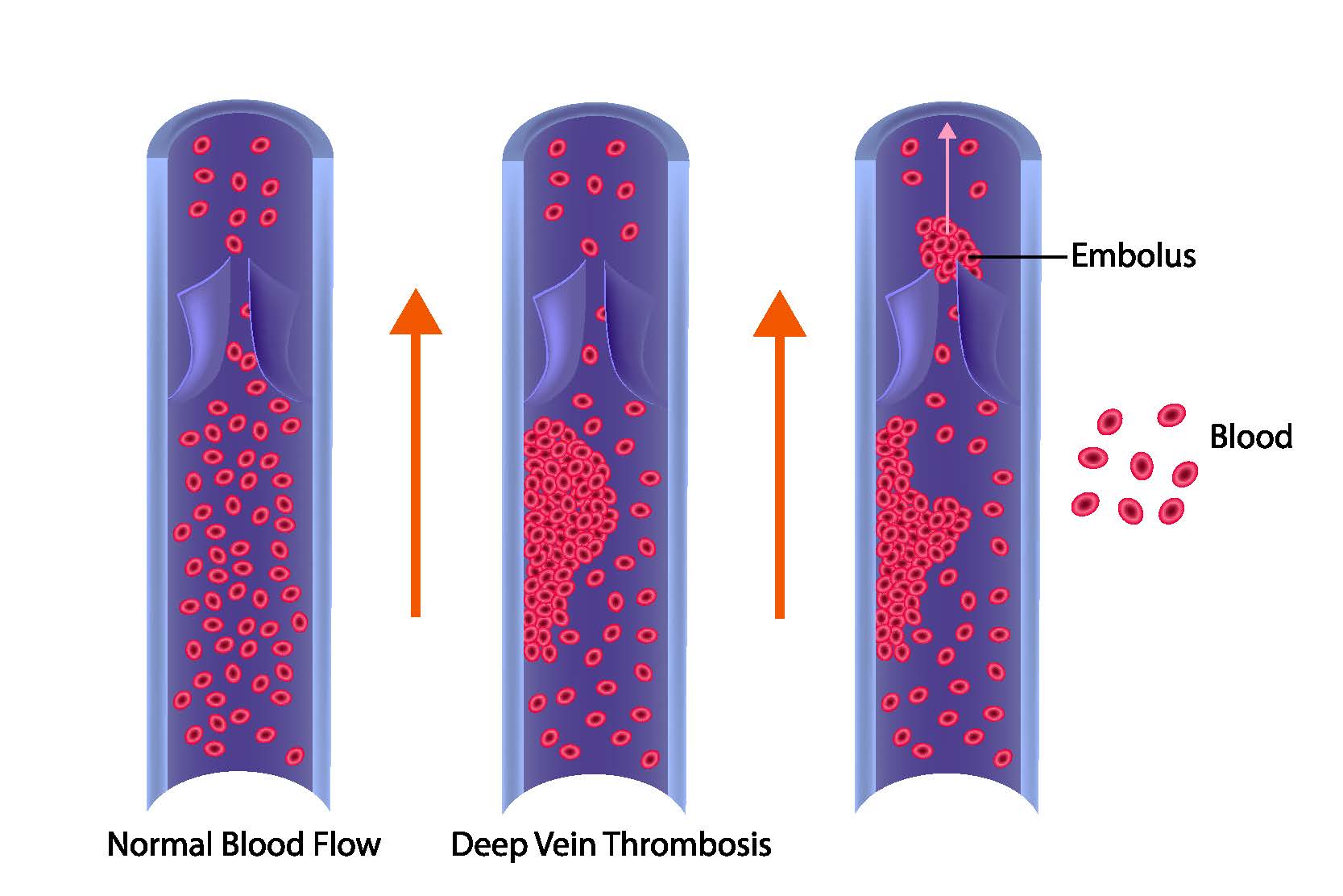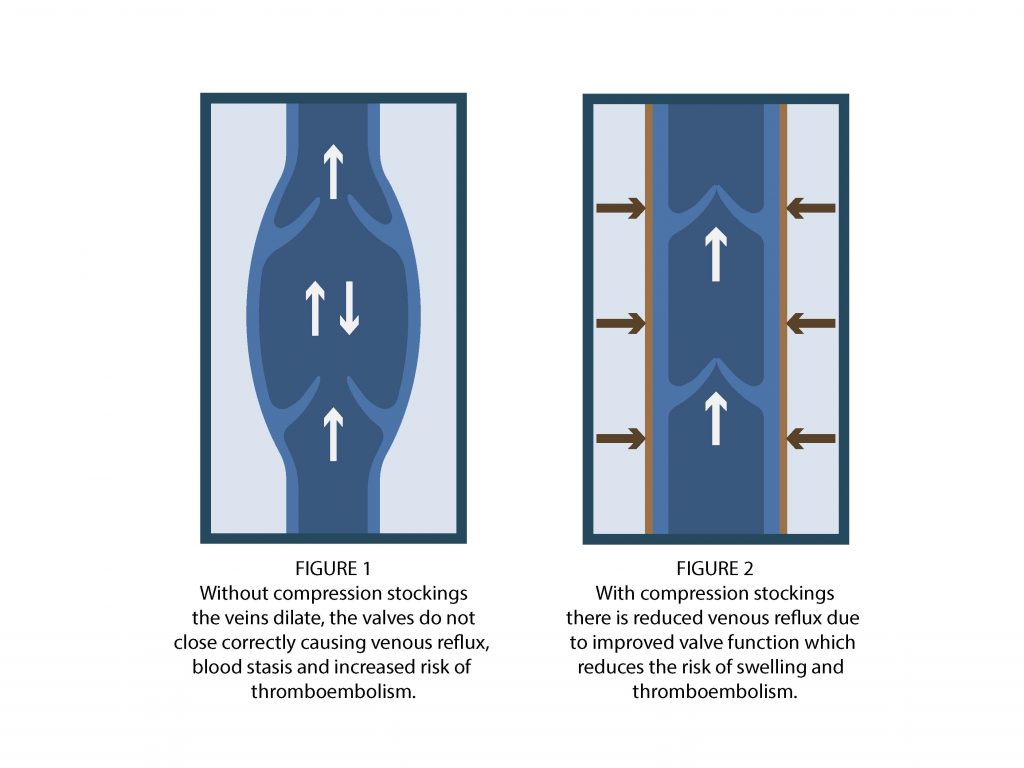What is DVT?
Deep vein thrombosis (DVT) is when blood clots in a deep vein (most often the leg). The situation can become life threatening when these clots break away and block the blood supply to the lungs, this is called pulmonary embolism (PE). DVT and PE are known collectively as venous thromboembolism (VTE).

Why does DVT happen?
DVT can sometimes occur for no apparent reason. The risk of developing one increases with:
- partial or complete blockage of blood flow due to immobility after injury, surgery or illness and during travel
- damage to the inside of a blood vessel due to medication such as chemotherapy
- blood clotting disorders
FACT
In the UK 1 in 4 people die from causes related to blood clots and between 55%-60% of these cases occur during or following hospitalisation.
SOURCE: www.thrombosisuk.org
Who is more at risk?
DVT can affect anyone, of any age, at any time without any obvious reason, however a DVT is more likely to happen if you:
- are over 40
- are either extremely tall or short
- are overweight
- have varicose veins
- smoke
- have had DVT before
- have a family history of blood clots
- take the contraceptive pill or HRT
- have cancer or heart failure
- have recently had major surgery
- have recently been confined to bed
- are pregnant or have had a baby in the previous 6 weeks
DVT and travel
The risk of VTE relating to long periods of prolonged seating, including travel, has been known for many years. Seat edge pressure behind the knees interferes with venous flow in the leg and can also increase the risk of DVT.
FACT
The risk of VTE approximately doubles following a flight of >4 hours and increases with the duration of the travel and with multiple flights, or periods of immobility, within a short period. Symptomless DVT might occur in up to 10% of long-haul airline travellers.
SOURCE: World Health Organisation Research into Global Hazards of Travel (WRIGHT)
FACT
The risk of symptomatic DVT is increased 2- to 4- after air travel. The risk was particularly high in women employees under the age 30 years who used oral contraceptives, and in individuals who were particularly short, tall, or overweight.
SOURCE: Kuipers, S., et al. (2007). The absolute risk of venous thrombosis after air travel: a cohort study of 8,755 employees of international organisations. PLoS Medicine, 4(9)
What are the symptoms of DVT?
In about 25% of cases there are no symptoms which is why it is always a good idea to take precautions. Both DVT and PE are serious conditions that require urgent investigation and treatment.
The most common symptoms of a blood clot in the leg are:
- breathlessness
- pain
- swelling
- warm skin on the leg
- redness, particularly at the back of the leg
How to prevent DVT
DVT can be prevented and taking preventative measures is fundamental. We recommend to:
- stay active, keep the calf muscle moving during the flight
- wear medical compression stockings
- maintain a healthy weight
- drink plenty of fluids to avoid dehydration
- avoid sitting for long periods of time
- do not cross your legs
- avoid smoking and alcohol
How do compression stockings work?
When we walk our muscles contract and squeeze the veins which helps pump blood out of the calves towards the heart. In a flight situation, calf muscles do not move and cannot exert mechanical pressure on the veins, which then become distended causing the valves inside may not close properly (Figure 1).
Medical compression garments can help reduce the venous diameter. This enables the valves inside the veins to close again and transport the blood more quickly towards the heart (Figure 2).

FACT
231 airline passengers aged over 50 years with no history of VTE were randomly assigned to wear Class 1 (18-21 mm Hg) below-knee graduated compression stockings, or no stockings, in journeys lasting more than eight hours. None of the passengers who wore the stockings had deep vein thrombosis, whereas 10% who did not wear stockings had asymptomatic deep calf vein thrombosis.
SOURCE: Scurr J. H., et al. (2001) Lancet. 2001 May 12; 357(9267):1485-9
FACT
The data from 2906 participants in nine different trials was combined, the results showed that wearing compression stockings has a significant impact in reducing oedema (leg swelling).
SOURCE: Clarke, M. J., et al. (2016). Compression stockings for preventing deep vein thrombosis in airline passengers. The Cochrane database of systematic reviews, 9(9)







